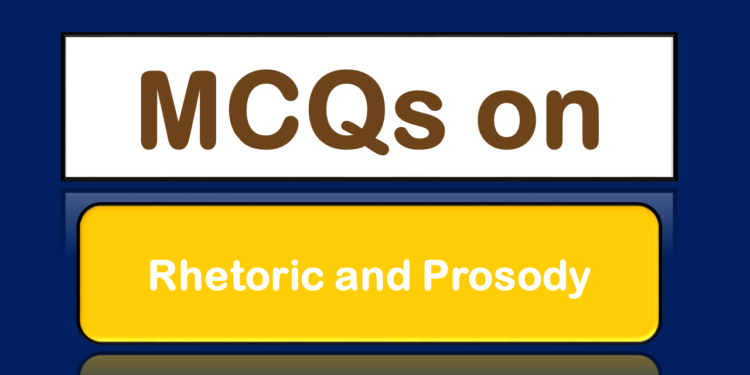50+ MCQs on Rhetoric and Prosody with Answers for UGC NET / SET Prepration
1. Rhetoric is the art of:
a) Writing fiction
b) Writing poetry
c) Persuasive speaking and writing
d) Conducting scientific research
2. Which of the following is NOT a rhetorical appeal?
a) Ethos
b) Pathos
c) Mythos
d) Logos
3. What is an example of an ethos appeal?
a) Using emotional language to persuade
b) Providing credible sources and expert opinions
c) Appealing to the audience’s sense of logic
d) Appealing to tradition and values
4. Pathos is an appeal to:
a) LogicMCQs on Rhetoric and Prosody
b) Emotion
c) EthicsMCQs on Rhetoric and Prosody
d) Authority
5. Logos refers to:
a) Emotional appeal
b) Logical appeal
c) Ethical appeal
d) Imagery
6. Which rhetorical device involves repetition of the same consonant sound at the beginning of adjacent words?
a) Alliteration
b) Assonance
c) Onomatopoeia
d) Consonance
7. “She sells seashells by the seashore” is an example of:
a) Alliteration
b) Assonance
c) Onomatopoeia
d) Consonance
8. What is the term for the repetition of vowel sounds in nearby words?
a) Alliteration
b) Assonance
c) Onomatopoeia
d) Consonance
9. The pattern of stressed and unstressed syllables in a line of poetry is known as:
a) Rhyme scheme
b) Meter
c) Stanza
d) Enjambment
10. Which of the following is NOT a common meter in English poetry?
a) Iambic pentameter
b) Trochaic tetrameter
c) Anapestic hexameter
d) Dactylic octameter
11. In iambic pentameter, each line contains:
a) Five stressed syllables
b) Five unstressed syllables
c) Ten stressed syllablesMCQs on Rhetoric and Prosody
d) Ten unstressed syllables
12. Which poetic foot consists of two unstressed syllables followed by a stressed syllable?
a) Iamb
b) Trochee
c) AnapestMCQs on Rhetoric and Prosody
d) Dactyl
13. The most common meter in English poetry is:
a) Iambic pentameter
b) Trochaic tetrameter
c) Anapestic hexameter
d) Dactylic octameter
14. A stanza consisting of four lines is called a:
a) Couplet
b) Quatrain
c) Sonnet
d) Tercet
Also Read-
15. What is the term for a pause within a line of poetry, often indicated by punctuation?
a) Enjambment
b) Caesura
c) Sonnet
d) Quatrain
16. A group of two lines in a poem is called a:
a) Couplet
b) Quatrain
c) Sonnet
d) Tercet
17. How many lines are there in a sonnet?
a) 10
b) 12
c) 14MCQs on Rhetoric and Prosody
d) 16
18. Which type of sonnet consists of an octave followed by a sestet?
a) Petrarchan (Italian) sonnetMCQs on Rhetoric and Prosody
b) Shakespearean (English) sonnet
c) Spenserian sonnet
d) Miltonic sonnet
19. Who is often credited with popularizing the Shakespearean (English) sonnet form?
b) John Milton
c) Geoffrey Chaucer
d) Edmund SpenserMCQs on Rhetoric and Prosody
20. A figure of speech in which an inanimate object or abstract concept is given human qualities is called:
a) Personification
b) Simile
c) Metaphor
d) HyperboleMCQs on Rhetoric and ProsodyMCQs on Rhetoric and ProsodyMCQs on Rhetoric and ProsodyMCQs on Rhetoric and Prosody
21. “The stars danced playfully in the moonlit sky” is an example of:
a) Personification
b) Simile
c) Metaphor
d) Hyperbole
22. In a metaphor, the comparison is made:
a) Using “like” or “as”
b) Directly, without using “like” or “as”
c) By exaggerating for effect
d) By giving human qualities to non-human objects
23. “The world is a stage” is an example of:
a) Personification
b) Simile
c) Metaphor
d) Hyperbole
24. Which term refers to the repetition of vowel sounds within nearby words?
a) Alliteration
b) Assonance
c) Onomatopoeia
d) Consonance
25. “The buzzing bees flew from flower to flower” is an example of:
a) Alliteration
b) Assonance
c) Onomatopoeia
d) Consonance
26. In poetry, what is the term for the use of words that imitate sounds?
a) Alliteration
b) Assonance
c) Onomatopoeia
d) Consonance
27. “The clock ticked loudly” is an example of:
a) Alliteration
b) Assonance
c) Onomatopoeia
d) Consonance
28. What is the term for a comparison between two unlike things using “like” or “as”?
a) Personification
b) Simile
c) Metaphor
d) Hyperbole
29. “Her eyes sparkled like diamonds” is an example of:
a) Personification
b) Simile
c) MetaphorMCQs on Rhetoric and Prosody
d) Hyperbole
30. In “The fog crept in on little cat feet,” the fog is compared to a cat using:
a) Personification
b) Simile
c) MetaphorMCQs on Rhetoric and Prosody MCQs on Rhetoric and Prosody
d) Hyperbole
31. The term “onomatopoeia” refers to:
a) Words that sound like what they mean
b) Words that rhyme with each other
c) Words that have multiple meanings
d) Words that are difficult to pronounce
32. “Buzz,” “hiss,” and “moo” are examples of:
a) SimilesMCQs on Rhetoric and Prosody
b) Metaphors
c) Onomatopoeia
d) Personification
33. What is the term for a figure of speech that involves an exaggerated statement or claim?
a) Personification
b) Simile
c) Metaphor
d) Hyperbole
34. “I’m so hungry I could eat a horse” is an example of:
a) Personification
b) Simile
c) Metaphor
d) HyperboleMCQs on Rhetoric and Prosody
35. Which figure of speech involves giving human qualities to non-human objects or abstract concepts?
a) Personification
b) Simile
c) Metaphor
d) Hyperbole
36. “The wind whispered through the trees” is an example of:
a) PersonificationMCQs on Rhetoric and Prosody
b) Simile
c) Metaphor
d) Hyperbole
37. What is the term for the repetition of the same consonant sound at the beginning of adjacent or closely connected words?
a) Alliteration
b) Assonance
c) OnomatopoeiaMCQs on Rhetoric and Prosody
d) Consonance
38. “Peter Piper picked a peck of pickled peppers” is an example of:
a) Alliteration
b) Assonance
c) OnomatopoeiaMCQs on Rhetoric and Prosody
d) Consonance
39. Which term refers to the overall sound and rhythm of a poem?
a) Rhyme schemeMCQs on Rhetoric and Prosody
b) Meter
c) Stanza
d) Enjambment
40. A group of lines forming a unit in a poem is called a:
a) Rhyme scheme
b) Meter
c) StanzaMCQs on Rhetoric and Prosody
d) Enjambment
41. In poetry, what is the term for the deliberate breaking of a sentence or phrase between lines?
a) Rhyme scheme
b) Meter
c) Stanza
d) Enjambment
42. “The woods are lovely, dark and deep,
But I have promises to keep,
And miles to go before I sleep,”
is an example of:
a) Rhyme scheme
b) Meter
c) StanzaMCQs on Rhetoric and Prosody
d) Enjambment
43. In a sonnet, what is the most common rhyme scheme for the first eight lines (octave)?
a) ABAB
b) AABB
c) ABBA
d) ABCB
44. In poetry, what is the term for the pattern of rhymes at the end of each line?
a) Rhyme scheme
b) Meter
c) Stanza
d) Enjambment
45. “Roses are red, violets are blue,
Sugar is sweet, and so are you,”
is an example of which rhyme scheme?
a) ABAB
b) AABB
c) ABBA
d) ABCB
46. Which of the following is a common metrical foot consisting of two syllables, with the stress falling on the second syllable?
a) Iamb
b) Trochee
c) Anapest
d) Dactyl
47. “To be or not to be, that is the question” is an example of:
a) Iambic pentameter
b) Trochaic tetrameter
c) Anapestic hexameter
d) Dactylic octameter
48. Which of the following is a common metrical foot consisting of three syllables, with the stress falling on the first syllable?
a) Iamb
b) Trochee
c) Anapest
d) Dactyl
49. In “The Raven” by Edgar Allan Poe, the meter is predominantly:
a) Iambic pentameter
b) Trochaic tetrameter
c) Anapestic hexameter
d) Dactylic octameter
50. Which figure of speech involves a direct comparison between two unlike things, without using “like” or “as”?
a) PersonificationMCQs on Rhetoric and Prosody
b) Simile
c) Metaphor
d) Hyperbole
Answer
1. c) Persuasive speaking and writing
2. c) Mythos
3. b) Providing credible sources and expert opinions
4. b) Emotion
5. b) Logical appeal
6. a) Alliteration
7. a) AlliterationMCQs on Rhetoric and Prosody
8. b) Assonance
9. b) MeterMCQs on Rhetoric and Prosody
10. d) Dactylic octameter
11. c) Ten stressed syllables
12. c) Anapest
13. a) Iambic pentameter
14. b) Quatrain
15. b) Caesura
16. a) Couplet
17. c) 14
18. a) Petrarchan (Italian) sonnet
19. d) Edmund Spenser
20. a) Personification
21. a) Personification
22. b) Directly, without using “like” or “as”
23. c) Metaphor
24. b) Assonance
25. c) Onomatopoeia
26. c) Onomatopoeia
27. c) Onomatopoeia
28. b) Simile
29. b) Simile
30. c) Metaphor
31. a) Words that sound like what they mean
32. c) Onomatopoeia
33. d) Hyperbole
34. d) Hyperbole
35. a) Personification
36. a) Personification
37. a) Alliteration
38. a) Alliteration
39. b) Meter
40. c) Stanza
41. d) Enjambment
42. c) Stanza
43. c) ABBAMCQs on Rhetoric and Prosody
44. a) Rhyme scheme
45. b) AABB
46. b) Trochee
47. a) Iambic pentameterMCQs on Rhetoric and Prosody
48. c) Anapest
49. b) Trochaic tetrameter
50. c) Metaphor
Related

















